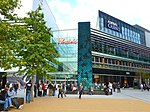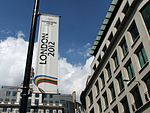Chobham Academy

Chobham Academy is a mixed all-through school and sixth form which opened in September 2013. The school is located on Cheering Lane in the East Village of Stratford in the London Borough of Newham, England. It has 1,800 student places and has a specialism in performing arts and English.Chobham Academy is located in buildings that were first used during the 2012 Summer Olympics as the main base for organising and managing teams. Rebuilt after the games, it opened in September 2013 as an education campus comprising: a nursery, primary and secondary school, sixth form and adult learning facility.As a school that was purpose-built to serve the new community established in the former Olympic Village, priority for admission into the school is given to those who live in East Village.The school is operated by the Harris Federation, a federation of primary and secondary academies in England. The school is sponsored by Lend Lease Group. Lend Lease have been responsible for the design, development and construction of East Village, on behalf of the London Organising Committee of the Olympic and Paralympic Games. The school building was designed by architects Allford Hall Monaghan Morris.
Excerpt from the Wikipedia article Chobham Academy (License: CC BY-SA 3.0, Authors, Images).Chobham Academy
Cheering Lane, London Stratford New Town (London Borough of Newham)
Geographical coordinates (GPS) Address Phone number Website Nearby Places Show on map
Geographical coordinates (GPS)
| Latitude | Longitude |
|---|---|
| N 51.549288888889 ° | E -0.0071666666666667 ° |
Address
Harris Academy Chobham
Cheering Lane
E20 1BD London, Stratford New Town (London Borough of Newham)
England, United Kingdom
Open on Google Maps











